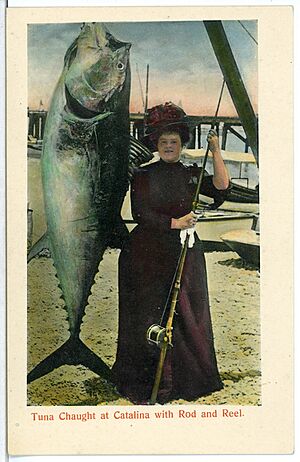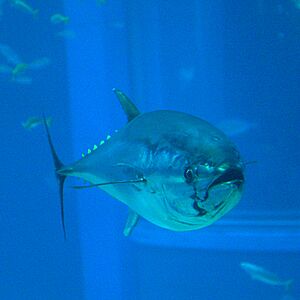Pacific bluefin tuna facts for kids
Quick facts for kids Pacific bluefin tuna |
|
|---|---|
 |
|
| At Tokyo Sea Life Park, Japan | |
| Conservation status | |
| Scientific classification | |
| Synonyms | |
|
The Pacific bluefin tuna (Thunnus orientalis) is a large, fast-swimming fish. It lives mostly in the northern Pacific Ocean. These amazing fish travel long distances, sometimes visiting the southern Pacific too.
In the past, Pacific bluefin tuna were often grouped with Atlantic bluefin tuna. Now, scientists usually see them as different species. Pacific bluefin tuna can grow very big. They can be as long as 3 meters (about 10 feet). They can also weigh up to 450 kilograms (about 990 pounds). That's like a small car!
Like other bluefin tuna, the Pacific bluefin is very valuable for fishing. Thousands of tons are caught each year. Experts believe too many of these fish have been caught. However, they are not currently being overfished. The IUCN says they are "near threatened." This means their numbers are getting low, but they are not yet in serious danger. Groups like Monterey Bay Aquarium's Seafood Watch and Greenpeace suggest avoiding eating bluefin tuna. This helps protect them.
Contents
Pacific Bluefin Tuna
Where They Live
The Pacific bluefin tuna mainly lives in the North Pacific Ocean. Their home stretches from the coast of East Asia to the western coast of North America. They usually live in the open ocean, far from land. They prefer places with mild temperatures. However, they can also be found in warmer tropical areas and closer to shore.
These tuna typically swim near the surface, down to about 200 meters (650 feet). But they have been seen much deeper, up to 550 meters (1,800 feet).
They lay their eggs in the northwestern Philippine Sea. This area includes waters near Honshu, Okinawa, and Taiwan. They also spawn in the Sea of Japan. Some tuna travel all the way to the East Pacific after spawning. They then return to these same areas to lay eggs again a few years later. Sometimes, they visit the Southern Hemisphere, like Australia or New Zealand.
Scientists believe all Pacific bluefin tuna belong to one large group, or "stock."
How Their Bodies Work
Staying Warm
Most fish are cold-blooded. This means their body temperature changes with the water around them. But tuna are special! They are warm-blooded, like birds and mammals. This means they can keep their body temperature steady.
Tuna have special organs near their muscles. These organs are called retia mirabilia. They are like tiny heat exchangers. They help keep the heat from leaving the tuna's body. When warm blood from the muscles goes back to the gills, it passes by cold blood coming from the gills. The heat from the warm blood transfers to the cold blood. This way, the tuna loses less heat to the cold ocean water.
Being warm-blooded gives tuna many advantages. They can swim in different water temperatures. They are not limited by changes in the weather. The extra heat also gives their muscles more power. This helps them swim very fast and powerfully.
Life Cycle
Pacific bluefin tuna usually become adults around 5 years old. At this age, they are about 1.5 meters (5 feet) long. They weigh about 60 kilograms (130 pounds). They can live for 15 to 26 years. Many tuna grow to be 2 meters (6.5 feet) long. The biggest ones can reach 3 meters (10 feet) in length. They can weigh up to 450 kilograms (990 pounds). Some reports even say they can weigh 550 kilograms (1,200 pounds)!
The largest Pacific bluefin tuna ever caught with a fishing rod weighed 411.6 kilograms (907 pounds). This record-breaking fish was caught in 2014.
Tuna lay their eggs from April to August. The exact time depends on where they are. In warmer southern areas, they spawn earlier. In cooler northern areas, they spawn later. A large female tuna can lay many eggs. Some can lay between 5 million and 25 million eggs!
Pacific bluefin tuna eat many different things. They mostly eat small schooling fish and squid. They also eat other sea creatures like pelagic red crabs and krill.
Tuna and People
Fishing for Tuna

Pacific bluefin tuna are very important for commercial fishing. Many people around the world fish for them to sell.
Raising Tuna on Farms
Japan is the biggest buyer of tuna. They also lead the way in tuna farming research. In 1979, Kinki University in Japan successfully raised bluefin tuna from eggs. In 2002, they managed to breed these farm-raised tuna. By 2007, they had a third generation of farm-raised tuna. This special tuna is now called Kindai tuna. "Kindai" is a short name for Kinki University.
Protecting Tuna
At first, Pacific bluefin tuna were not seen as threatened. But in 2014, their status changed to "Vulnerable." This meant they were at risk. Now, they are listed as "Near Threatened." This is a step better than "Vulnerable."
Recent studies show that the tuna population is growing. In 2010, their numbers were very low. By 2020, they had increased quite a bit. This happened because less fishing has been done.
However, fishing for Pacific bluefin tuna is still a challenge. They travel across many different areas. This means different groups manage the fishing. Sometimes, their rules don't match up. Experts suggest that one group should be in charge. They also recommend catching fewer young tuna. About 90% of the Pacific bluefin tuna caught are young fish.
Groups like Monterey Bay Aquarium's Seafood Watch and Greenpeace advise people not to eat bluefin tuna. This helps protect the species.
Tuna as Food
About 80% of Pacific and Atlantic bluefin tuna are eaten in Japan. Tuna is especially popular for sashimi and sushi. These fish can sell for very high prices. In Japan, eating certain foods for the first time each year is considered good luck. Bluefin tuna is one of these foods.
Winning the first tuna auction of the year is a big deal. It often brings a lot of attention. This can make the prices go very high. For example, in 2013, a Pacific bluefin tuna sold for a record $1.76 million in Tokyo. In 2019, another one sold for an even higher price: $3.1 million! This shows how valuable these fish are.



